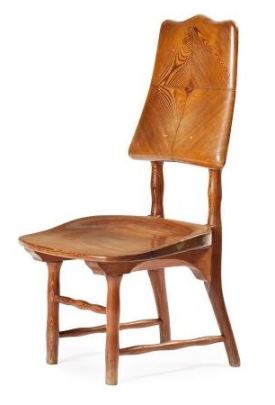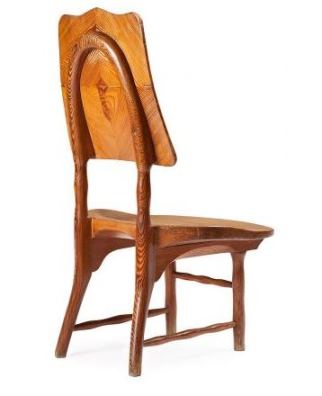Seamstress chair
 When Anton Gaudí renovated the house of Passeig de Gràcia n. 43 for the factory owner Josep Batlló, between 1904 and 1906, he also designed furniture.
When Anton Gaudí renovated the house of Passeig de Gràcia n. 43 for the factory owner Josep Batlló, between 1904 and 1906, he also designed furniture.
One of the pieces is a «seamstress chair». The architect took the traditional Catalan cadira cosidora, which is still produced and sold, and he redesigned it coherently with the decoration of the Batlló house. The result was a masterpiece.
The Catalan seamstress chair is lower and wider than normal chairs. It is very comfortable to sit for hours with your legs straight, which makes it good for working with large pieces of cloth with which you have to bend or stretch your arms. It is also light and easy to transport wherever women formed a sewing circle. Or in the case of wealthy families to the room where they performed this activity: where the lady of the house would sew if she was fond of it, or when the seamstress came to the house.
Gaudí kept all these features of the traditional Catalan seamstress chair, which makes them useful, and he increased them to their maximum potential. His seamstress chair is not a smaller version of the other chairs of the Batlló house, but specifically designed to be a seamstress chair. It even retains the three cross bars —infrequent elements in Gaudí’s furniture— between the legs, with fusiform shapes that closely resemble the traditional model of a seamstress model.
Like all Gaudí furniture it is ergonomic, in both the backrest and the seat. The back support has a shaped handle that makes it easy to hold and carry. The material is pine wood melis, lighter than American oak that makes up the rest of the furniture of Batlló house, which were not expected to be moved frequently. 
The support consists of four coupled parts, whose wood grain suggests concentric diamonds. The seat and legs resemble those of the other chairs of the Batlló house. They have no edges; all have been rounded, as Gaudí always did.
The various elements are assembled without screws or nails, only by oak pegs or different traditional techniques.
The wood surface was polished and flaxseed oil was applied, but no varnish was added in order to enhance the natural colour and shine.
The Batlló house furniture was manufactured in mass production by Cases & Bardés. We do not know if the seamstress chair was made in these workshops or it was a work of Gaudí’s personal carpenter, Joan Munné i Seraní. Copies were not made because it was an experimental prototype constructed before the entire furniture project, either because Gaudí had designed it then or after, specifically for Mrs. Batlló or her seamstress.
The Gaudí seamstress chair, preserved by descendants of Josep Batlló, came to auction on Balcli's, Barcelona, July 2013. It shows that, at an unknown time, the legs were sawed to decrease its height.
All rights reserved
Last update: 06/05/2016